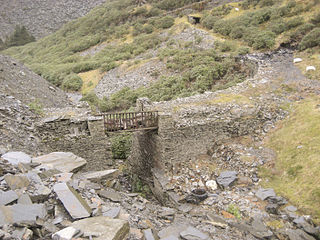
Severn Tunnel Junction railway station is a minor station on the western side of the Severn Tunnel in the village of Rogiet, Monmouthshire, Wales. It is 123.5 miles (198.8 km) from London Paddington and lies at the junction of the South Wales Main Line from London and the Gloucester to Newport Line.

Lamport is a village and civil parish in West Northamptonshire, England. The village is on the A508, about 8 miles (13 km) south of Market Harborough and 8 miles (13 km) north of Northampton. Nearby is Lamport Hall. At the time of the 2001 census, the parish's population was 207 people, including Hanging Houghton and increasing to 225 at the 2011 Census.

Finedon is a town in North Northamptonshire, England, with a population at the 2011 census of 4,309 people. In 1086 when the Domesday Book was completed, Finedon was a large royal manor, previously held by Queen Edith, wife of Edward the Confessor. From the 1860s the parish was much excavated for its iron ore, which lay underneath a layer of limestone and was quarried over the course of 100 years or more. Local furnaces produced pig iron and later the quarries supplied ore for the steel works at Corby. A disused quarry face in the south of the parish is a geological SSSI.

Birkenhead Mollington Street was a former Traction Maintenance Depot located at Mollington Street in Birkenhead, England, on the Birkenhead Dock Branch railway. Although never directly connected by rail, the depot was situated less than 200 m (660 ft) from Birkenhead Central railway station. The depot serviced steam and subsequently diesel locomotives until 1985, when it was closed and demolished. As of 2018, the site of the depot is still disused.

Bletchley TMD is a railway traction maintenance depot situated in Bletchley, Milton Keynes in Buckinghamshire, to the north east of Bletchley railway station, on a siding off the Marston Vale line. The depot is operated by London Northwestern Railway.

Neville Hill is a railway Train Maintenance Depot in Osmondthorpe, Leeds, England on the Leeds to Selby Line. The depot is situated 2 miles 14 chains (3.5 km) to the east of Leeds railway station on the north side of the line.

Toton Traction Maintenance Depot or Toton Sidings is a large Traction Maintenance Depot located in Toton, Nottinghamshire. The TOPS depot code for the depot is TO. Before TOPS, the shed code was 16A.

Hither Green (London) Traction Maintenance Depot or Hither Green (London) TMD is a railway depot used for the maintenance and servicing of freight trains adjacent to the Hither Green marshalling yard. The depot is a hub for moving freight around southeast England. Hither Green TMD is owned and operated by DBS. The official depot code is HG. In steam days the shed code was 73C.

Some industrial narrow-gauge railways in the United Kingdom and the Isle of Man were primarily built to serve quarrying, mining, and similar industries. Some of these narrow-gauge railways offered passenger services for employees or workmen, but they did not run public passenger trains. They are listed by the primary industry they served.

Shrewsbury TMD is a railway Traction Maintenance Depot (TMD) situated in Coleham, Shrewsbury, England. The TMD forms part of Coleham Depot, a permanent way depot operated by Network Rail. The code for the TMD is 'SB'.

The Purbeck Mineral and Mining Museum exists to preserve and interpret the historic extractive industries in ball clay mining in the Isle of Purbeck. The museum is located adjacent to Norden station on the Swanage Railway and is open from the end of March to the end of September on weekends, some weekdays and Bank Holidays.

Saltley TMD was a Traction Maintenance Depot located in Saltley, Birmingham, England. The depot was situated on the east side of the line between Birmingham New Street and Water Orton, and was near Saltley station until the station closed in 1968.

Perth Carriage Servicing Depot is a depot and stabling point located in Perth, Perthshire, Scotland. The depot is on the eastern side of the Highland Main Line, adjacent to Perth station.

Leicester Carriage Sidings are located in Leicester, Leicestershire, England, on the eastern side of the Midland Main Line to the north of Leicester station.

Canklow Engine Shed was a Traction Maintenance Depot located in Canklow, Rotherham, England. The depot opened in 1900 and was situated on the Midland Main Line, 1.5 miles (2.4 km) south of Rotherham Masborough station. The depot area had six lines; three of these fed into just one line that went through the shed, whilst the other three were sidings, one of which had the coal stage.

Finedon Top Lodge Quarry, also known as Finedon Gullet is a 0.9 hectare geological Site of Special Scientific Interest east of Wellingborough in Northamptonshire. It is a Geological Conservation Review site revealing a sequence of middle Jurassic limestones, sandstones and ironstones, and is the type section for a sequence of sedimentary rocks known as the 'Wellingborough Member'. It was created by quarrying for the underlying ironstone for use at Wellingborough and Corby Steelworks; the ore was transported by the 1,000 mm gauge Wellingborough Tramway.

The Waltham Iron Ore Tramway was a 1,000 mm gauge industrial tramway serving the ironstone pits of the Waltham Iron Ore Company, a subsidiary of the Staveley Coal and Iron Company. It was located to the north of the village of Branston in Leicestershire on the edge of the Belvoir Estate. The tramway operated from 1884 until 1958.

The Finedonhill Tramway was a British industrial narrow-gauge railway which operated under various ownership between 1875 and 1926.

The Wellingborough Tramway was an industrial narrow-gauge railway that connected a series of ironstone mines and quarries with the Midland Railway and later with the ironworks on the north side of Wellingborough. In various forms, the tramway operated between 1875 and 1966.
Neilson's Tramway was a British industrial narrow-gauge railway which operated from 1881 to 1929.




















